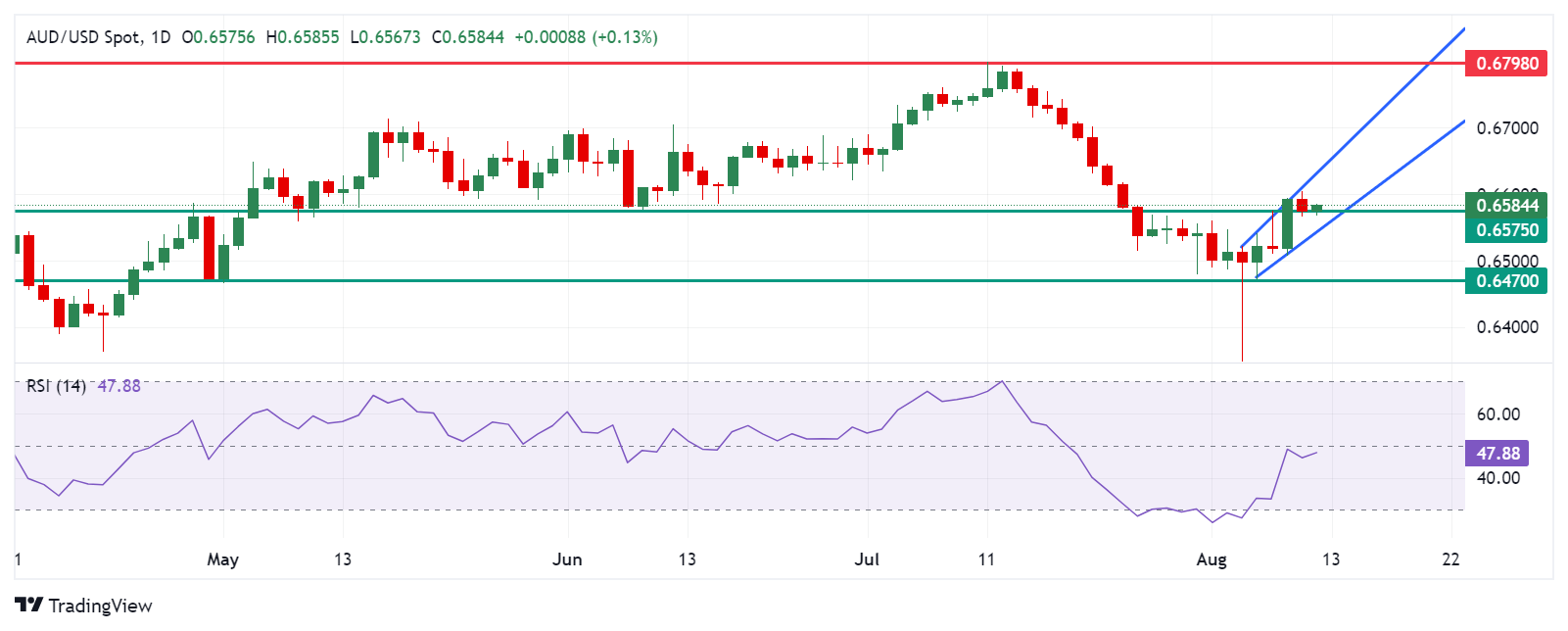- The Australian Dollar is appreciating as the RBA could raise rates again if necessary.
- Safe-haven flows may limit AUD upside amid Middle East tensions.
- Fed Governor Michelle Bowman suggested the U.S. central bank may not be ready to cut rates in September.
The Australian Dollar (AUD) is retracing its recent losses against the US Dollar (USD) on Monday. The AUD/USD pair is appreciating due to the hawkish sentiment surrounding the Reserve Bank of Australia (RBA). Additionally, encouraging inflation in China, a close trading partner of Australia, might have provided support for the Australian Dollar.
RBA Governor Michele Bullock last week stressed the importance of remaining cautious regarding inflation risks and said the central bank would not hesitate to raise rates again to combat inflation if necessary. These comments came just days after the RBA kept rates steady at 4.35% for a sixth consecutive meeting.
As for the USD, market expectations of a possible rate cut by the Federal Reserve (Fed) in September could put pressure on the US Dollar (USD), potentially providing support for the AUD/USD pair.
Investors are likely to focus on U.S. producer inflation data due on Tuesday and consumer inflation figures on Wednesday. Traders are looking for confirmation that price growth remains stable.
Daily Market Wrap: Australian Dollar Rises on Hawkish RBA
- The risk-sensitive AUD’s upside could be limited by safe-haven flows amid rising geopolitical tensions in the Middle East. On Sunday, Defense Minister Yoav Gallant informed U.S. Defense Secretary Lloyd Austin that Iran’s military activities indicate preparations for a significant attack on Israel, according to Axios writer Barak Ravid.
- On Sunday, Federal Reserve Governor Michelle Bowman said she continues to see upside risks to inflation and continued strength in the labor market. This suggests the Fed may not be ready to cut rates at its next meeting in September, according to Bloomberg.
- China’s Consumer Price Index (CPI) rose 0.5% year-on-year in July, beating the 0.3% expected and the previous readings of 0.2%. Meanwhile, the monthly index also rose 0.5%, turning around from the previous decline of 0.2%.
- Westpac updated its forecast for the RBA, now predicting the first rate cut will occur in February 2025, a change from the previous forecast in November 2024. They also revised their terminal rate forecast to 3.35%, from 3.10% previously. The RBA is now seen to be more cautious, needing more robust evidence before considering rate cuts.
- On Thursday, Kansas City Fed President Jeffrey Schmid said that easing monetary policy could be “appropriate” if inflation remains low. Schmid noted that the Fed’s current policy is “not that tight” and that while the Fed is close to its 2% inflation target, it has not yet fully achieved it, according to Reuters.
- Last week, Treasurer Jim Chalmers countered the RBA’s view that the economy remains too robust and that large government budgets are contributing to prolonged inflation, according to Macrobusiness.
- RBA Governor Michele Bullock said the board had seriously considered raising the cash rate from 4.35% to 4.6% due to ongoing concerns about excessive demand in the economy. In addition, RBA Chief Economist Sarah Hunter noted that the Australian economy is performing somewhat better than the RBA previously anticipated.
Technical Analysis: Australian Dollar hovers around 0.6600, aligned with retracement support
The Australian dollar is trading around 0.6590 on Monday. The daily chart analysis shows that the AUD/USD pair is positioned within an ascending channel, which indicates a bullish bias. Meanwhile, the 14-day Relative Strength Index (RSI) is consolidating below the 50 level. A move above this level could suggest a strengthening of the bullish momentum.
In terms of resistance, the AUD/USD pair could test the upper boundary of the ascending channel at the level of 0.6630. A break above this level could propel the pair towards the region near its six-month high of 0.6798.
On the downside, the AUD/USD pair could find immediate support at the retracement level of 0.6575. A drop below this level could reinforce a bearish bias, potentially pushing the pair towards the lower boundary of the ascending channel around 0.6540. Additional support is seen at the retracement level of 0.6470.
AUD/USD: Daily Chart
Australian Dollar PRICE Today
The table below shows the Australian Dollar (AUD) exchange rate against major currencies today. The Australian Dollar was the strongest currency against the Japanese Yen.
| USD | EUR | GBP | JPY | CAD | AUD | NZD | CHF | |
|---|---|---|---|---|---|---|---|---|
| USD | -0.03% | 0.03% | 0.24% | -0.01% | -0.11% | -0.14% | 0.00% | |
| EUR | 0.03% | 0.09% | 0.24% | 0.01% | -0.19% | -0.10% | 0.05% | |
| GBP | -0.03% | -0.09% | 0.41% | -0.07% | -0.28% | -0.19% | -0.03% | |
| JPY | -0.24% | -0.24% | -0.41% | -0.24% | -0.41% | -0.37% | -0.25% | |
| CAD | 0.01% | -0.01% | 0.07% | 0.24% | -0.15% | -0.12% | 0.05% | |
| AUD | 0.11% | 0.19% | 0.28% | 0.41% | 0.15% | 0.09% | 0.25% | |
| NZD | 0.14% | 0.10% | 0.19% | 0.37% | 0.12% | -0.09% | 0.16% | |
| CHF | -0.01% | -0.05% | 0.03% | 0.25% | -0.05% | -0.25% | -0.16% |
The heatmap shows percentage changes of major currencies. The base currency is selected from the left column, while the quote currency is selected from the top row. For example, if you choose the Australian Dollar from the left column and move along the horizontal line to the US Dollar, the percentage change shown in the chart will represent the AUD (base)/USD (quote).
The RBA FAQs
The Reserve Bank of Australia (RBA) sets interest rates and manages Australia’s monetary policy. Decisions are made by a Board of Governors at 11 meetings per year and at ad hoc emergency meetings as necessary. The RBA’s primary mandate is to maintain price stability, which means an inflation rate of 2%-3%, but also to “…contribute to currency stability, full employment and the economic prosperity and well-being of the Australian people.” Its main tool for achieving this is to raise or lower interest rates. Relatively high interest rates will strengthen the Australian Dollar (AUD) and vice versa. Other tools of the RBA are quantitative easing and monetary tightening.
Although inflation has traditionally always been considered a negative factor for currencies, as it reduces the value of money in general, the opposite has actually occurred in modern times with the relaxation of cross-border capital controls. Moderately high inflation now tends to lead central banks to raise their interest rates, which in turn has the effect of attracting more capital inflows from global investors looking for a lucrative place to store their money. This increases the demand for the local currency, which in Australia’s case is the Australian dollar.
Macroeconomic data gauges the health of an economy and can impact the value of its currency. Investors prefer to invest their capital in safe, growing economies rather than in weak, shrinking ones. Greater capital inflows boost aggregate demand and the value of the domestic currency. Classic indicators such as GDP, manufacturing and services PMIs, employment and consumer sentiment surveys can influence the AUD. A strong economy may encourage the Reserve Bank of Australia to raise interest rates, also supporting the AUD.
Quantitative Easing (QE) is a tool used in extreme situations where lowering interest rates is not enough to restore the flow of credit in the economy. QE is the process by which the Reserve Bank of Australia (RBA) prints Australian Dollars (AUD) in order to purchase assets – usually government or corporate bonds – from financial institutions, thereby providing them with much-needed liquidity. QE usually results in a weaker AUD.
Quantitative tightening (QT) is the reverse of QE. It is carried out after QE, when the economic recovery is underway and inflation is starting to rise. While in QE the Reserve Bank of Australia (RBA) buys government and corporate bonds from financial institutions to provide them with liquidity, in QT the RBA stops buying more assets and stops reinvesting the maturing principal of the bonds it already owns. This would be positive (or bullish) for the Australian dollar.
Source: Fx Street
I am Joshua Winder, a senior-level journalist and editor at World Stock Market. I specialize in covering news related to the stock market and economic trends. With more than 8 years of experience in this field, I have become an expert in financial reporting.








